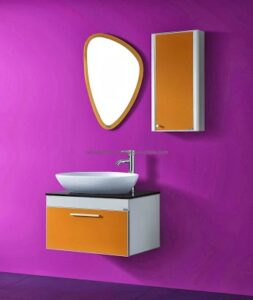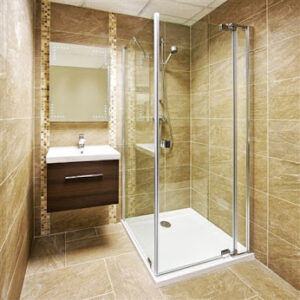How to Choose Your Bathroom Tiles: A Complete Guide
Choosing the right bathroom tiles is essential to creating a stylish, functional, and durable space. Tiles are one of the most significant elements in bathroom design, and they not only define the aesthetic but also play a role in the room’s functionality. Whether you’re redesigning a small powder room or a spacious bathroom, selecting the perfect tiles can elevate your design and ensure the space remains practical for years to come.
This guide will take you through everything you need to know to make informed decisions when choosing your bathroom tiles.
1. Consider the Tile Material
The material of the tile is one of the most important factors when choosing bathroom tiles. Different materials have varying levels of durability, water resistance, and style. Here’s a breakdown of common bathroom tile materials:
- Ceramic Tiles: Ceramic is one of the most popular and affordable options for bathroom tiles. It’s water-resistant, easy to maintain, and comes in a variety of designs, sizes, and finishes.
- Porcelain Tiles: Porcelain tiles are a type of ceramic but are made with a denser material. They are extremely durable and resistant to moisture, making them ideal for bathroom floors and walls.
- Glass Tiles: Glass tiles are known for their shiny, sleek appearance and ability to reflect light. They’re ideal for adding a touch of luxury but are typically used as accents or backsplashes due to their fragility.
- Natural Stone Tiles: Materials like marble, granite, and slate can add a high-end, timeless appeal to your bathroom. However, these require sealing and maintenance to prevent staining or water damage.
- Mosaic Tiles: Mosaic tiles come in small pieces and are often used to create intricate patterns. These tiles can be made from ceramic, glass, or stone and are great for accent walls, backsplashes, or shower floors.
2. Choose the Right Tile Size
The size of your tiles can significantly impact the look and feel of your bathroom. Larger tiles can make a small bathroom feel more spacious by reducing the number of grout lines. Smaller tiles are often used for intricate designs or to create a more traditional look.
- Small Tiles: Best for intricate designs, backsplashes, and showers. Small mosaic tiles create a luxurious, detailed look, but more grout lines require more maintenance.
- Large Tiles: These are ideal for creating a sleek, modern design with minimal grout lines. Large tiles work well for both floors and walls, as they give the illusion of space in smaller bathrooms.
- Rectangular Tiles: Subway tiles are a popular rectangular option. They can be laid in a brick pattern, herringbone, or stacked pattern for added design flexibility.
3. Think About Tile Texture and Finish
Tiles come in various textures and finishes, and each can make a different impact on your bathroom’s design. Here are some finishes to consider:
- Glossy Finish: Glossy tiles are shiny and reflective, making them ideal for brightening up a space with natural light. They’re also easy to clean but may show water spots and soap scum more readily.
- Matte Finish: Matte tiles offer a soft, subtle look and are excellent for creating a more modern or rustic vibe. They provide more grip and are less slippery, making them a great option for bathroom floors, especially in wet areas.
- Textured Tiles: Textured tiles, like those with a wood, stone, or fabric effect, add depth and interest to the bathroom. They also provide a more slip-resistant surface for bathroom floors.
- Polished Finish: Polished tiles, often made of natural stone, have a glossy surface that gives an elegant, refined look. They’re ideal for walls but should be used with caution on floors as they can be slippery.
4. Consider the Tile Color
The color of your bathroom tiles is essential to setting the overall tone of the space. The right color can make your bathroom feel larger, cozier, brighter, or more sophisticated. Here are some color options and their effects:
- White: Classic and timeless, white tiles are perfect for creating a clean and fresh look. White tiles can make a bathroom feel more expansive and bright. They’re particularly well-suited for smaller spaces.
- Neutral Tones: Light gray, beige, or taupe tiles create a calm, neutral palette and allow for flexibility in other design elements. These tones work well with various colors for accents or decorative elements.
- Bold Colors: Rich colors like deep blues, greens, and purples can add personality and drama to the space. These are ideal for creating focal points on accent walls or feature areas.
- Black: Black tiles can make a bold statement and add sophistication to a bathroom. However, they can make a space feel smaller, so they’re best used in larger bathrooms or as accents.
- Pastels: Soft pastel shades like mint, blush, or powder blue are perfect for creating a calming atmosphere. These are often used in vintage-inspired or coastal bathrooms.
5. Create Patterns and Visual Interest
Tiles can be arranged in various patterns to create an eye-catching look. The right pattern can enhance the visual appeal of your bathroom and give it character. Here are some popular tile patterns:
- Herringbone: This zigzag pattern is often used with rectangular tiles to create a visually dynamic look. It’s a stylish option for bathroom floors or accent walls.
- Chevron: Similar to herringbone, but with a continuous V-shape. Chevron patterns are a bold, modern choice for bathrooms.
- Subway Tiles: Subway tiles are classic rectangular tiles arranged in a brick pattern. They work well in traditional, modern, or even industrial-style bathrooms.
- Grid or Straight Lay: A simple and clean pattern where tiles are laid straight, in rows and columns. This is an excellent choice for larger tiles that create a seamless, contemporary look.
- Diagonal: Diagonal tile arrangements can make a small bathroom appear larger and are a unique way to add flair to your design.
6. Consider Tile Durability and Maintenance
Bathrooms are high-moisture areas, so it’s crucial to choose tiles that can withstand the humidity and wear-and-tear of daily use. Here are some factors to consider regarding tile durability:
- Water Resistance: Porcelain and ceramic tiles are highly resistant to water, making them ideal for showers, bathtubs, and bathroom floors. Natural stone tiles like marble or granite need to be sealed properly to prevent water absorption.
- Scratch Resistance: Stone tiles like granite are resistant to scratches and can handle high-traffic areas well. Glass tiles can be more prone to scratching, so they’re better for walls than floors.
- Maintenance Requirements: Consider how much upkeep you’re willing to do. Glossy tiles are easier to clean but may show water spots, while matte tiles tend to hide dirt better but might require a deeper clean.
7. Stay Within Your Budget
Bathroom tiles come in a wide range of price points, from budget-friendly ceramic options to high-end natural stone. Set a clear budget before you start shopping, and make sure to account for the costs of grout, adhesives, and labor if you’re hiring a professional installer.
If you’re working with a limited budget, consider using premium tiles as accents or in smaller areas like the backsplash or shower wall while using more affordable tiles for the rest of the bathroom.
Conclusion
Choosing the right bathroom tiles is essential to achieving a space that is not only beautiful but also practical and long-lasting. By considering the material, size, texture, color, pattern, durability, and budget, you can create a bathroom that fits your needs and reflects your personal style.
Whether you’re creating a spa-like retreat, a modern haven, or a minimalist sanctuary, the right tiles will help you achieve the perfect balance of function and aesthetics.


